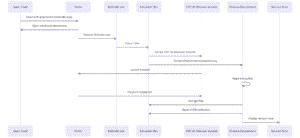
FAQ: Top 5 Essential Difference Between www and http You Should Know
FAQ
Approx read time: 5.9 min.
Difference between www and http – Why Do Some Websites Start with “www.” and Others with “http://”?
Difference between www and http
Understanding why some websites start with “www.” while others use “http://” involves delving into the structure and protocols of the web. Here’s a detailed explanation:
“www.” Prefix
World Wide Web and Subdomains:
- “www.” stands for “World Wide Web.” It’s a prefix used to indicate that the address is part of the web.
- “www.” is technically a subdomain of the main domain. For example, “www.google.com” is a subdomain of “google.com“
- Historically, “www.” was used to distinguish web servers from other services running on the same domain, such as email (mail.example.com) or FTP servers (ftp.example.com).
Convention and Usability: -Difference between www and http
- By convention, “www.” subdomains are often set up to take you to the same place as the root domain (google.com and www.google.com lead to the same site).
- This practice avoids confusion and ensures that users can access the website regardless of which version they type.
Email Addresses: – Difference between www and http
- You never see “www” in an email address (e.g., johndoe@example.com, not johndoe@www.example.com) because “www” is specific to web access and email operates on different protocols (like SMTP, IMAP).
Historical Context: -Difference between www and http
- The web was invented after the internet. The internet originally focused on email, file transfers, and remote terminals. When the web was introduced, “www” was used to signify a publicly accessible web portal.
Analogy: -Difference between www and http
- Imagine “google.com” as an office complex with multiple buildings (subdomains). The “www” building is prominently placed, representing the main public entrance, making it easy to find compared to other buildings like “images” (images.google.com) or “maps” (maps.google.com).
“http://” and “https://” Prefixes
HTTP and HTTPS Protocols:
- “http://” stands for HyperText Transfer Protocol, the foundation of data communication on the web. It tells your browser how to communicate with the website.
- “https://” is the secure version (HyperText Transfer Protocol Secure). It encrypts data between the server and browser using SSL/TLS, enhancing security.
Security and Data Integrity:
- HTTP: Data is transferred in plain text, vulnerable to interception.
- HTTPS: Data is encrypted, protecting confidentiality and integrity. It’s essential for transmitting sensitive information like passwords or credit card numbers.
SEO and User Trust:
- Search engines and modern browsers prioritize HTTPS for its security benefits. Sites using HTTPS rank higher in search results and are trusted more by users.
- Browsers may display warnings when accessing non-HTTPS sites, deterring users from visiting.
Ports and URI Schemes – Difference between www and http
Ports:
- Each service on the internet runs on a specific port. The default port for HTTP is 80, and for HTTPS, it’s 443.
- Specifying a port (e.g., http://www.google.com:80) can override defaults, but using incorrect ports can lead to connection errors (e.g., http://www.google.com:443 would try to use HTTP on an HTTPS port).
URI Schemes:
- The “http” and “https” are part of a larger set of protocols known as URI schemes. Other examples include “ftp://” for file transfers.
- These schemes indicate the type of connection and protocol to use, guiding browsers on how to access resources.
Practical Implications – Difference between www and http
Redirection and Canonicalization:
- Websites often redirect from non-www to www (or vice versa) to maintain consistency and improve SEO.
- This avoids issues like duplicate content and ensures users have a seamless experience.
Session Management:
- Some sites may improperly handle sessions across “www” and non-“www” domains, requiring users to log in again. Proper configuration ensures a unified user experience.
Load Balancing and Maintenance:
- Using prefixes like “www2” can help distribute traffic or indicate maintenance periods, ensuring the main site remains accessible.
Summary – Difference between www and http
- “www” is a subdomain, historically used to indicate web content, and is a convention rather than a necessity.
- “http://” and “https://” indicate the protocol for data transfer, with HTTPS providing a secure connection.
- Proper configuration of these elements ensures security, usability, and seamless user experience on the web.
Understanding these prefixes and their roles helps clarify how the web operates and how users interact with websites securely and efficiently.
When you change your website to redirect from www.miltonmarketing.com to https://miltonmarketing.com, you generally only need to add miltonmarketing.com as a property in Google Analytics. Here’s why:
Google Analytics Property Setup
- Primary Domain:
- Since
https://miltonmarketing.comwill be your primary domain, you should add this version as the main property in Google Analytics.
- Since
- Redirection:
- If you set up a proper 301 redirect from
www.miltonmarketing.comtohttps://miltonmarketing.com, all traffic will be redirected to the non-www version. This ensures that all analytics data is consolidated under one property.
- If you set up a proper 301 redirect from
Steps to Ensure Proper Tracking:
- Set Up the Property:
- In Google Analytics, set up a new property or ensure your existing property is for
https://miltonmarketing.com.
- In Google Analytics, set up a new property or ensure your existing property is for
- Verify Property:
- Make sure that the property is verified in Google Search Console for
https://miltonmarketing.com.
- Make sure that the property is verified in Google Search Console for
- 301 Redirect:
- Implement a 301 redirect from
www.miltonmarketing.comtohttps://miltonmarketing.comon your server. This tells search engines and browsers that the non-www version is the preferred one.
- Implement a 301 redirect from
- Update Google Search Console:
- Add
https://miltonmarketing.comas a property in Google Search Console if it isn’t already, and make it your primary domain.
- Add
- Annotations:
- In Google Analytics, add an annotation to mark the date when the change was made. This helps in tracking the impact of the change on your traffic and other metrics.
Why Not Add Both?
- Consolidation of Data: Adding both
www.miltonmarketing.comandmiltonmarketing.comcan lead to fragmented data, making it harder to get a clear picture of your traffic and performance. - Double-Headed Site Stats: If you use both properties without proper forwarding and setup, you might end up with duplicate site statistics. This means that traffic to
www.miltonmarketing.comandmiltonmarketing.comwill be tracked separately, leading to confusion and potential inaccuracies in your analytics data. This can result in inflated or misleading metrics, as user sessions might be split between the two properties, complicating your understanding of user behavior and site performance. - Simplification: It simplifies your analytics setup and maintenance, ensuring all data flows into a single property without confusion.
By following these steps, you’ll ensure that all traffic is tracked correctly under the single property of https://miltonmarketing.com, providing you with accurate analytics data and avoiding the pitfalls of double-headed site stats.
Related Videos:
Related Posts:
How Can You Troubleshoot Your Refrigerator Like an HVAC Technician?
How Many Weeks Are There in a Year?
How many days until Christmas?
Unlocking Digital Curiosities: The Top 1000 Google Queries Unveiled
CSS HTML JAVASCRIPT Online Compiler Code on the go
Hacking the IoT: Vulnerabilities and Prevention Methods
Step Up Your Game: The Ultimate Guide to Choosing the Best Exercise Shoes










